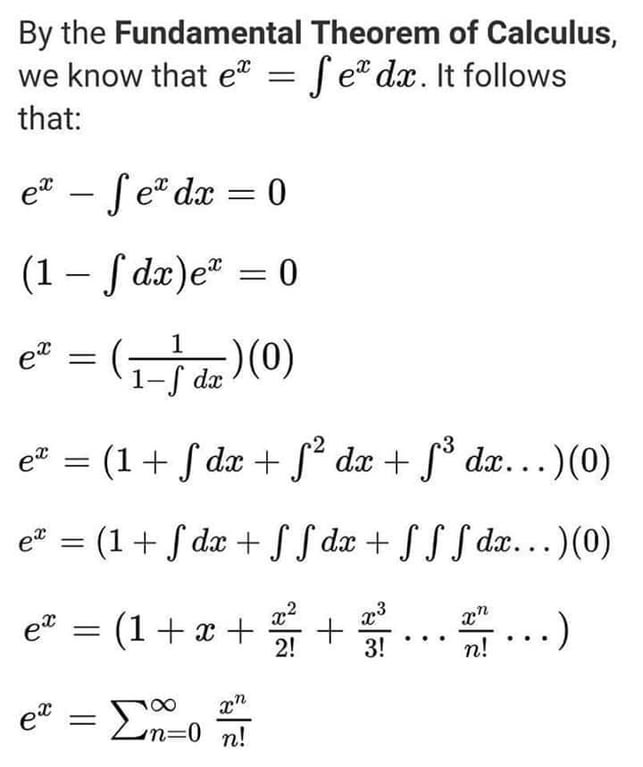this post was submitted on 22 Jan 2024
6 points (100.0% liked)
Math Memes
1506 readers
159 users here now
Memes related to mathematics.
Rules:
1: Memes must be related to mathematics in some way.
2: No bigotry of any kind.
founded 1 year ago
MODERATORS
you are viewing a single comment's thread
view the rest of the comments
view the rest of the comments

Except the first assumption that e^x = its own integral, everything else actually makes sense (except the DX are in the wrong powers). You simply treat the "1" and "integral dx" as operators, formally functions from R^R into R^R and "(0)" as calculating the value of the operator on a constant-valued function 0. EDIT: the step 1/(1-integral) = the limit of a certain series is slightly dubious, but I believe it can be formally proven as well. EDIT 2: I was proven wrong, read the comments
is it immediately obvious that the inverse of the operator L is 1/L though? Much less the series expansion for the operator...
If you try to fill in the technical details it will be a lot of work compared to a simpler calculus based alternative
But then again some Mathematicians spent the better half of the century formalizing the mathematics used by Physicists like Dirac (spoiler: they all turned out to be valid)
After careful consideration I have come to the conclusion that the inverse of the operator L is obviously not 1/L and you are absolutely right. This derivation is complete nonsense, my apologies. In fact no such inverse can even exist for the operator 1 - integral, as this function is not an injection.
What is meant here, I believe, is (1 - Int)^-1. Writing 1/(1 - Int) is an abuse of notation, especially when the numerator isn't just 1 but another operator, which loses the distinction between a left and a right inverse. But for a bounded linear operator on a normed vector space, and I think Int over an appropriately chosen space of functions qualifies, (1 - Int)^-1 equals the Neumann series \sum_k=0^∞ Int^k, exactly as in the derivation.
Int is injective: Take Int f = Int g, apply the derivative, and the fundamental theorem gives you f = g. I think you can make it bijective by working with equivalence classes of functions that differ only by a constant.
Int is definitely not injective when you consider noncontinuous functions (such as f(X)={1 iff X=0, else 0}). If you consider only continuous functions, then unfortunately 1-Int is also not injective. Consider for example e^x and 2e^x. Unfortunately your idea with equivalence classes also fails, as for L = 1 - Int, L(f) = L(g) implies only that L(f-g) = 0, so for f(X)=X and g(X)=X + e^x L(f) = L(g)
Sets of measure zero are unfair. But you're right, the second line in the image is basically an eigenvector equation for Int and eigenvalue 1, where the whole point is that there is a subspace that is mapped to zero by the operator.
I'm still curious if one could make this work. This looks similar to problems encountered in perturbation theory, when you look for eigenvectors of an operator related to one where you have the spectrum.